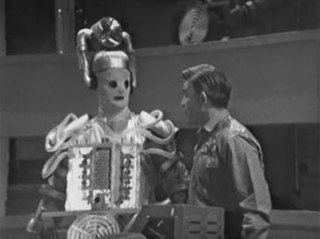
Digital video is an electronic representation of moving visual images (video) in the form of encoded digital data. This is in contrast to analog video, which represents moving visual images in the form of analog signals. Digital video comprises a series of digital images displayed in rapid succession, usually at 24, 30, or 60 frames per second. Digital video has many advantages such as easy copying, multicasting, sharing and storage.

Video is an electronic medium for the recording, copying, playback, broadcasting, and display of moving visual media. Video was first developed for mechanical television systems, which were quickly replaced by cathode-ray tube (CRT) systems, which, in turn, were replaced by flat-panel displays of several types.

Kinescope, shortened to kine, also known as telerecording in Britain, is a recording of a television program on motion picture film, directly through a lens focused on the screen of a video monitor. The process was pioneered during the 1940s for the preservation, re-broadcasting and sale of television programs before the introduction of quadruplex videotape, which from 1956 eventually superseded the use of kinescopes for all of these purposes. Kinescopes were the only practical way to preserve live television broadcasts prior to videotape.

Telecine is the process of transferring film into video and is performed in a color suite. The term is also used to refer to the equipment used in this post-production process.

A camcorder is a self-contained portable electronic device with video and recording as its primary function. It is typically equipped with an articulating screen mounted on the left side, a belt to facilitate holding on the right side, hot-swappable battery facing towards the user, hot-swappable recording media, and an internally contained quiet optical zoom lens.

Quatermass and the Pit is a British television science-fiction serial transmitted live by BBC Television in December 1958 and January 1959. It was the third and last of the BBC's Quatermass serials, although the chief character, Professor Bernard Quatermass, reappeared in a 1979 ITV production called Quatermass. Like its predecessors, Quatermass and the Pit was written by Nigel Kneale.
The Tomb of the Cybermen is the first serial of the fifth season of the British science fiction television series Doctor Who, which was originally broadcast in four weekly parts on BBC1 from 2 to 23 September 1967.

The Quatermass Experiment is a British science fiction serial broadcast by BBC Television during the summer of 1953 and re-staged by BBC Four in 2005. Set in the near future against the background of a British space programme, it tells the story of the first crewed flight into space, supervised by Professor Bernard Quatermass of the British Experimental Rocket Group.

Nineteen Eighty-Four is a British television adaptation of the 1949 novel of the same name by George Orwell, originally broadcast on BBC Television in December 1954. The production proved to be hugely controversial, with questions asked in Parliament and many viewer complaints over its supposed subversive nature and horrific content. It starred Peter Cushing, Yvonne Mitchell, Donald Pleasence and André Morell.
Tele-snaps were off-screen photographs of British television broadcasts, taken and sold commercially by John Cura. From 1947 until 1968, Cura ran a business selling the 250,000-plus tele-snaps he took. The photographs were snapped in half of a normal frame of 35mm film, at an exposure of 1/25th of a second. Generally around 70–80 tele-snaps were taken of each programme. They were mostly purchased by actors and directors to use as records and examples of their work before the prevalence of videocassette recorders.

HDV is a format for recording of high-definition video on DV videocassette tape. The format was originally developed by JVC and supported by Sony, Canon, and Sharp. The four companies formed the HDV Consortium in September 2003.
Film look is a process in which video is altered in overall appearance to appear to have been shot on film stock. The process is usually electronic, although filmizing can sometimes occur as an unintentional by-product of some optical techniques, such as telerecording. The effect is the exact opposite of a process called VidFIRE.
Film-out is the process in the computer graphics, video production and filmmaking disciplines of transferring images or animation from videotape or digital files to a traditional film print. Film-out is a broad term that encompasses the conversion of frame rates, color correction, as well as the actual printing, also called scannior recording.

The Tenth Planet is the partly missing second serial of the fourth season in the British science fiction television series Doctor Who, which was first broadcast in four weekly parts from 8 to 29 October 1966. It was William Hartnell's last regular appearance as the First Doctor, and the first story to feature the process later termed "regeneration", whereby the lead character, The Doctor, undergoes a transformation into a new physical form. Patrick Troughton makes his first, uncredited appearance as the Second Doctor.
The Doctor Who Restoration Team is a loose collection of Doctor Who fans, many within the television industry, who restore Doctor Who episodes for release on a variety of formats.

Several portions of the long-running British science-fiction television programme Doctor Who are no longer held by the BBC. Between 1967 and 1978, the BBC routinely deleted archive programmes for various practical reasons—lack of space, scarcity of materials, and a lack of rebroadcast rights. As a result, 97 of 253 episodes from the programme's first six years are currently missing, primarily from Seasons 3, 4 and 5, leaving 26 serials incomplete. Many more were considered lost until recovered from various sources, mostly overseas broadcasters.
The Mind of Evil is the second serial of the eighth season of the British science fiction television series Doctor Who, which was first broadcast in six weekly parts on BBC1 from 30 January to 6 March 1971.

Motion interpolation or motion-compensated frame interpolation (MCFI) is a form of video processing in which intermediate film, video or animation frames are generated between existing ones by means of interpolation, in an attempt to make animation more fluid, to compensate for display motion blur, and for fake slow motion effects.
Colour recovery is a process that restores lost colour to television programmes that were originally recorded on colour videotape but for which only black-and-white copies exist. This is not the same as colourisation, a process by which colour is artificially added to source material that was always black-and-white, or used to enhance poor-quality original sources. Colour recovery is a newer process and is fundamentally different from colourisation. Most of the work has been performed on PAL programmes, but the concept is not fundamentally restricted to that system.

Lost television broadcasts are mostly those early television programs which cannot be accounted for in studio archives usually because of deliberate destruction or neglect.












